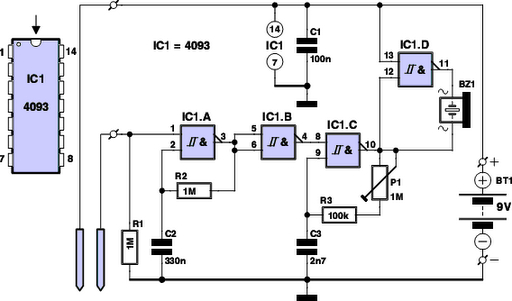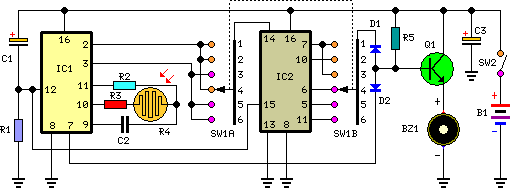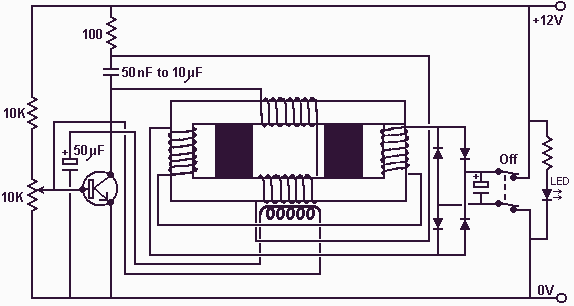
Single Alarm Circuit

This is a single alarm circuit. The circuit includes automatic exit and entry delays, a timed bell cut-off, and a system reset. It has provisions for normally open and normally closed inputs.
The single alarm circuit is designed to provide security and safety through various features that enhance its functionality. The automatic exit and entry delays allow users to leave and enter the protected area without triggering the alarm immediately, providing a grace period for disarming the system. The timed bell cut-off feature ensures that the alarm will sound for a predetermined duration, preventing it from ringing indefinitely and reducing the likelihood of nuisance alarms.
The system reset function allows users to easily reset the alarm system after it has been triggered, enabling quick restoration of the security status. The circuit accommodates both normally open (NO) and normally closed (NC) configurations, providing flexibility in sensor integration. Normally open contacts will complete the circuit when activated, while normally closed contacts will break the circuit when activated, allowing for a variety of sensor types to be used, such as door contacts and motion detectors.
The schematic for this circuit typically includes a microcontroller or timer IC to manage the timing functions, along with relay outputs to control the alarm sounder and other connected devices. The power supply section ensures that the circuit operates reliably, often incorporating voltage regulation to protect sensitive components. Additionally, a visual indicator, such as an LED, may be included to provide a status signal for the system, indicating whether it is armed or disarmed.
Overall, this alarm circuit design effectively combines essential security features with user-friendly operations, making it suitable for residential and commercial applications.Here is single alarm circuit. The circuit features automatic exit and entry delays, timed bell cut-off and system reset. It has provision for normally open and. 🔗 External reference
The single alarm circuit is designed to provide security and safety through various features that enhance its functionality. The automatic exit and entry delays allow users to leave and enter the protected area without triggering the alarm immediately, providing a grace period for disarming the system. The timed bell cut-off feature ensures that the alarm will sound for a predetermined duration, preventing it from ringing indefinitely and reducing the likelihood of nuisance alarms.
The system reset function allows users to easily reset the alarm system after it has been triggered, enabling quick restoration of the security status. The circuit accommodates both normally open (NO) and normally closed (NC) configurations, providing flexibility in sensor integration. Normally open contacts will complete the circuit when activated, while normally closed contacts will break the circuit when activated, allowing for a variety of sensor types to be used, such as door contacts and motion detectors.
The schematic for this circuit typically includes a microcontroller or timer IC to manage the timing functions, along with relay outputs to control the alarm sounder and other connected devices. The power supply section ensures that the circuit operates reliably, often incorporating voltage regulation to protect sensitive components. Additionally, a visual indicator, such as an LED, may be included to provide a status signal for the system, indicating whether it is armed or disarmed.
Overall, this alarm circuit design effectively combines essential security features with user-friendly operations, making it suitable for residential and commercial applications.Here is single alarm circuit. The circuit features automatic exit and entry delays, timed bell cut-off and system reset. It has provision for normally open and. 🔗 External reference





